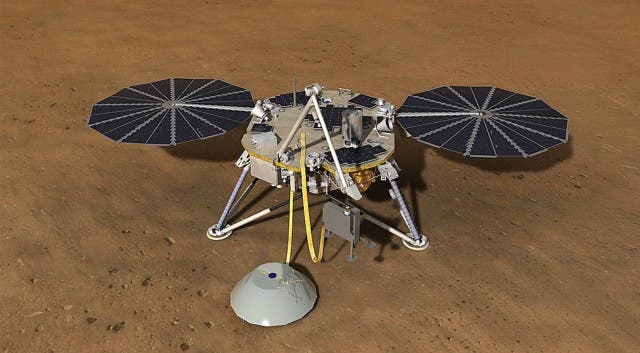Part of the reason why Earth is a world teeming with life while Mars is a barren wasteland is due to the presence of our planet’s magnetic field. This invisible barrier shields the atmosphere from the harmful effects of the solar wind.
But, that’s not to say Mars doesn’t have a planetary magnetic field at all — it’s just tiny relative to Earth’s. Now, NASA’s InSight lander has found it’s actually 10 times stronger than expected.

Unlike other NASA missions to the Martian surface, InSight isn’t a rover — it’s a static lander.
It touched down on the red planet surface about a year and a half ago with two major goals. One is understanding how rocky planets formed and evolved by measuring the interior structure and processes of Mars. The other is figuring out just how tectonically active Mars is today, and how often meteorites impact it.
InSight was the first mission to measure seismic activity on Mars. It also has a magnetic sensor that allows InSight to measure the strength of the magnetic field at the lander location, a hallow crater called “Homestead hollow”, found in a flat region called Elysium Planitia.
Previously, the only reliable measurements of Mars’ magnetic field were performed by orbiting satellites that were hovering hundreds of kilometers from the red planet’s surface.
According to the measurements reported in Nature Geosciences, Mars’ magnetic field is actually 10 times stronger than scientists were led to believe from satellite readings. This would make Mars’ magnetic field, while still very weak compared to Earth’s much stronger than initially thought.
Earth’s magnetic field is generated by the motion of molten iron alloys in its outer core, which acts as a planetary dynamo, generating a massive magnetic field called the magnetosphere. It extends for several tens of thousands of kilometers into space, well above the atmosphere, sheltering the planet from charged particles of the solar wind and cosmic rays that would otherwise strip away the upper atmosphere, including the ozone layer that protects life from harmful ultraviolet radiation.
Earth isn’t unique in this respect. Jupiter has masses of liquid metallic hydrogen in its outer mantle, creating the largest planetary magnetic field in the solar system. Uranus generates a global magnetosphere closer to the surface, which leads to some very strange quadrupole field effects — rather than just a north and a south, there are another two poles. Mars also used to have a magnetic field, but it suddenly switched off around four billion years ago.
Scientists aren’t sure how the red planet lost its magnetosphere but there are currently two leading theories. The first says that its core shut down, deactivating the dynamo and consequently Mars’ global magnetic field. The other leading hypothesis suggests that massive heat generated by large asteroid impacts warmed the outer layer of the planet to such a degree that it shut down convection from the hot core to the mantle.
After Mars’ lost its magnetic field, the atmosphere soon followed. With nothing to shelter it from cosmic rays and solar storms, the atmosphere thinned to the point that it’s now roughly 100 times less dense than Earth’s atmosphere. Mars is still continuously losing its atmosphere at a rate of about 100 grams of atmospheric gas every second.
According to NASA, there are still ‘fossil’ magnetic fields embedded in certain features of the red planet’s surface. The magnetic field recently measured by InSight is believed to emanate from very old rocks that are several hundred meters below the surface.
“Geological mapping and InSight seismic data suggest that much or all of the magnetization sources are carried in basement rocks, which are at least 3.9 billion years old and are overlain by between 200 m and ~10 km of lava flows and modified ancient terrain,” the authors of the new study wrote.
The new measurements of the red planet’s magnetic field change nothing about the prospects of finding life on Mars. It’s still very low — so low that the InSight lander could also easily detect solar wind in its vicinity. Nevertheless, the new findings add to a growing body of knowledge about Mars’ internal structure and geological history.









